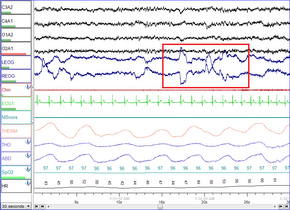
Back Polisomnografie Afrikaans تخطيط النوم Arabic Polisomnoqrafiya Azerbaijani Polisomnografia Catalan Polysomnographie German Polisomnografía Spanish Polüsomnograafia Estonian آزمایش چندگانه خواب Persian Polysomnographie French Polisomnografi ID
| Polysomnography | |
|---|---|
 Polysomnographic record of REM sleep. Eye movements highlighted by red rectangle. | |
| ICD-9-CM | 89.17 |
| MeSH | D017286 |
| OPS-301 code | 1-790 |
| MedlinePlus | 003932 |
| LOINC | 28633-6 |
Polysomnography (PSG) is a multi-parameter type of sleep study[1] and a diagnostic tool in sleep medicine. The test result is called a polysomnogram, also abbreviated PSG. The name is derived from Greek and Latin roots: the Greek πολύς (polus for "many, much", indicating many channels), the Latin somnus ("sleep"), and the Greek γράφειν (graphein, "to write").
Type I polysomnography is a sleep study performed overnight with the patient continuously monitored by a credentialed technologist. It records the physiological changes that occur during sleep, usually at night, though some labs can accommodate shift workers and people with circadian rhythm sleep disorders who sleep at other times. The PSG monitors many body functions, including brain activity (EEG), eye movements (EOG), muscle activity or skeletal muscle activation (EMG), and heart rhythm (ECG)1. After the identification of the sleep disorder sleep apnea in the 1970s, breathing functions, respiratory airflow, and respiratory effort indicators were added along with peripheral pulse oximetry. Polysomnography no longer includes NPT monitoring for erectile dysfunction, as it is reported that all male patients will experience erections during phasic REM sleep, regardless of dream content.
Limited channel polysomnography, or unattended home sleep tests, are called Type II–IV channel polysomnography. Polysomnography should only be performed by technicians and technologists who are specifically accredited in sleep medicine. However, at times nurses and respiratory therapists perform polysomnography without specific knowledge and training in the field.
Polysomnography data can be directly related to sleep onset latency (SOL), REM-sleep onset latency, number of awakenings during the sleep period, total sleep duration, percentages and durations of every sleep stage, and number of arousals. It may also record other information crucial for diagnostics that are not directly linked with sleep, such as movements, respiration, and cardiovascular parameters. In any case, through polysomnographic evaluation, other information (such as body temperature or esophageal pH) can be obtained according to the patient's or the study's needs.[2]
Video-EEG polysomnography, which combines polysomnography with video recording, has been described as more effective than polysomnography alone for the evaluation of sleep troubles such as parasomnias, because it allows easier correlation of EEG and polysomnography with bodily motion.[3]
- ^ Ibáñez, Vanessa; Silva, Josep; Cauli, Omar (2018-05-25). "A survey on sleep assessment methods". PeerJ. 6: e4849. doi:10.7717/peerj.4849. ISSN 2167-8359. PMC 5971842. PMID 29844990.
- ^ Orr, W. C. (1985). "Utilization of polysomnography in the assessment of sleep disorders". The Medical clinics of North America, 69(6), 1153–1167.
- ^ Aldrich, M. S., & Jahnke, B. (1991). "Diagnostic value of video‐EEG polysomnography". Neurology, 41(7), 1060.
© MMXXIII Rich X Search. We shall prevail. All rights reserved. Rich X Search